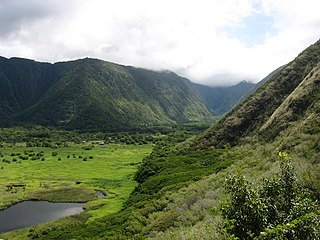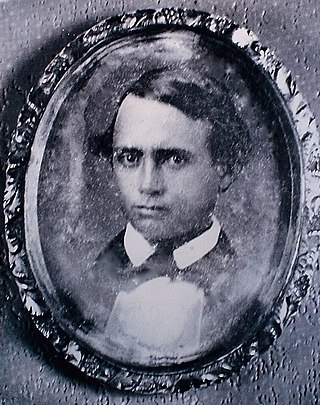Related Research Articles

Molokai is the fifth most populated of the eight major islands that make up the Hawaiian Islands archipelago in the middle of the Pacific Ocean. It is 38 by 10 miles at its greatest length and width with a usable land area of 260 sq mi (673.40 km2), making it the fifth-largest in size of the main Hawaiian Islands and the 27th largest island in the United States. It lies southeast of Oʻahu across the 25 mi (40 km) wide Kaʻiwi Channel and north of Lānaʻi, separated from it by the Kalohi Channel.

Kahaimoelea was a Hawaiian chief, who ruled as the Aliʻi Nui of Hawaiʻi from 1285 to 1315. He was the sovereign king or chief of the island of Hawaiʻi. He is sometimes referred as Kahai IV or Kahiamoeleaikaʻaikupou.

Rudolph Wilhelm Meyer (1826–1897) was a German who managed an early agricultural business in the Kingdom of Hawaii.
The Aliʻi nui were high chiefs of the four main Hawaiian Islands. The rulers of Molokaʻi, like those of the other Hawaiian islands, claimed descent from god Wākea.
High Chief Kamauaua was a member of Hawaiian aristocracy and a ruler of Molokai. Although Kamauaua’s name appears as the first one on the list of Molokai’s rulers, it’s likely Kamauaua was not the first monarch of Molokaʻi.

Kalahumoku I—also known as Kalahuimoku—was an ancient Hawaiian noble and Chief of Hana, Hawaii. It's unknown when Kalahumoku was born. The Chief is mentioned in old chants.
Alapaʻi was a Chief of Hawaiʻi in ancient Hawaii. He was an usurper to the throne, but was considered a good ruler, one who loved the common people, although there is a story that he was responsible for the death of High Chief Keōua. Alapaʻi's title in Hawaiian was Aliʻi.
Kamaiʻole is a chief mentioned in Hawaiian chants and legends. He was Aliʻi Nui ("king") by usurpation.
Kalanipehu was a High Chief on the Hawaiian island of Molokai in the 17th century. His name is known from ancient chants.
Hualani was a High Chiefess of Molokai in ancient Hawaii.

William Keolaloa Kahānui Sumner, Jr. was a high chief of the Kingdom of Hawaii through his mother's family; his father was an English captain from Northampton. Sumner married a Tahitian princess. Aided by royal family connections, he became a major landowner and politician in Hawaii.
Kalapana was a High Chief who lived in ancient Hawaii.
Keaunui was a High Chief of ʻEwa, Waiʻanae and Waialua in ancient Hawaii. He was a member of the Nanaulu line and is also known as Keaunui-a-Maweke.
Mulielealiʻi, also known as Miʻi-i-ele-aliʻi, was an ancient Hawaiian High Chief who lived on the island of Oahu, and is mentioned in ancient chants and writings by Abraham Fornander. His title is Aliʻi Nui.
Chief Kalehenui was an ancient Hawaiian nobleman (Aliʻi) of Tahitian ancestry, and he lived on Oahu.
George Naʻea, was a high chief of the Kingdom of Hawaii, and father of Queen Emma of Hawaii. He became one of the first Native Hawaiians to contract leprosy and the disease became known as maʻi aliʻi in the Hawaiian language because of this association.
Hineuki was a Hawaiian noble lady and Chiefess of the island of Hawaiʻi as the wife of Kukohou, Aliʻi Nui of Hawaiʻi. She was named after the goddess Hina, who was one of the most important deities in the religion of the Ancient Hawaiians.
Malamaʻihanaʻae was a Hawaiian noble lady and a High Chiefess of the Big Island — island of Hawaii. She was a close relative and the wife of the High Chief Kalapana.
Laʻakapu was an ancient Hawaiian noble lady and a High Chiefess of the Big Island (Hawaiʻi) as a wife of Kahoukapu, Aliʻi Nui of Hawaiʻi. She was the mother of the High Chief Kauholanuimahu, who succeeded his father.
Keʻoloʻewa was a Native Hawaiian and a High Chief of Molokai. Because of his father, Keʻoloʻewa is also known as Keʻoloʻewa-a-Kamauaua, since Keʻoloʻewa's parents were Lord Kamauaua—the first known ruler of Moloka‘i—and his Chiefess consort, Lady Hinakeha. Hinakeha—likely named after Hina, the Moon goddess—and her spouse were Aliʻi, ancient Hawaiian aristocracy.
References
- ↑ Peleioholani, Solomon Lehuanui Kalaniomaiheuila (1906). Genealogy of the Robinson family, and ancient legends and chants of Hawaii, Honolulu Bulletin Publishing Company.
- ↑ Catherine C. Summers, "Molokai: A Site Survey," Pacific Anthropological Records, No. 14, (Honolulu, HI: Department of Anthropology, Bernice P. Bishop Museum, 1971).
- ↑ Parents of Kalahumoku. ″Kanipahu (Chief of Hawaii Island). He married Hualani (Hulani II) (Molokai Chiefess)."
- ↑ David Malo. Hawaiian Antiquities.
- Abraham Fornander. An Account of the Polynesian Race: Its Origin and Migrations. Rutland, VT: Charles E. Tuttle Company, 1969.